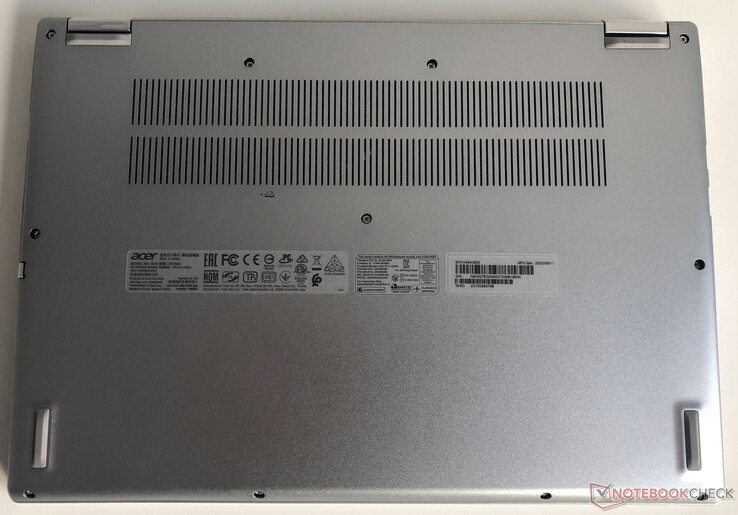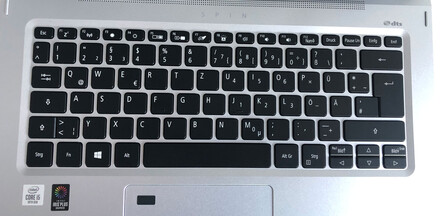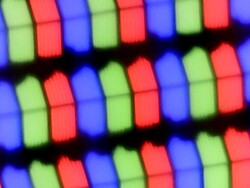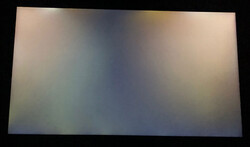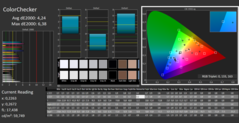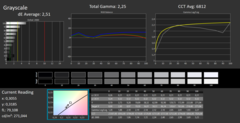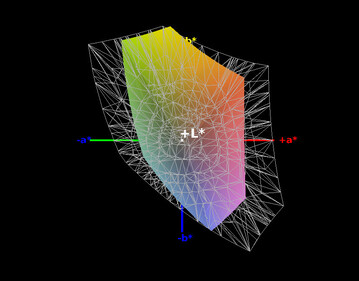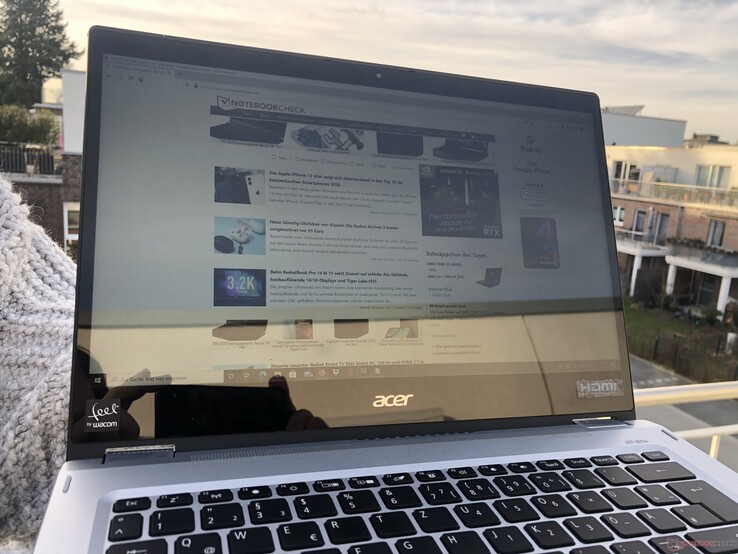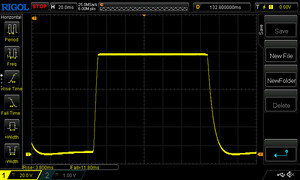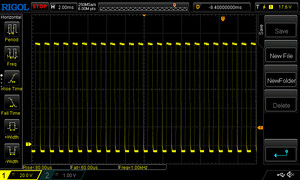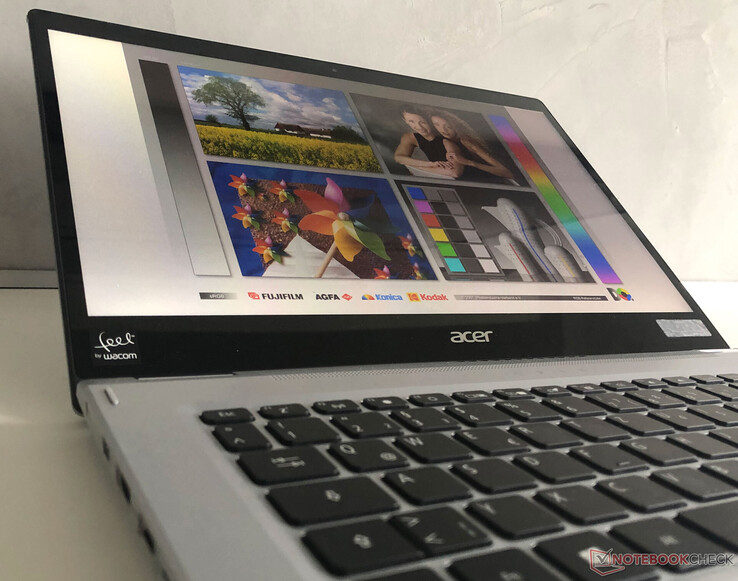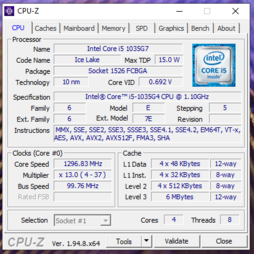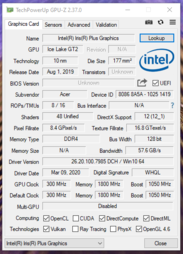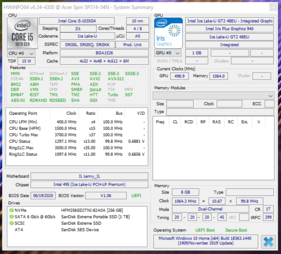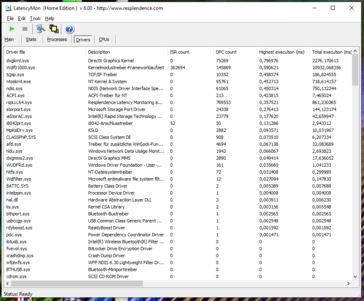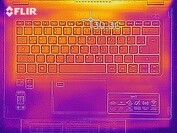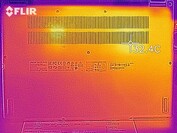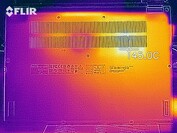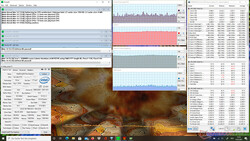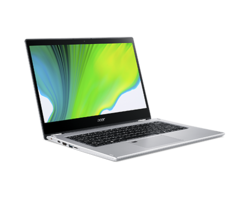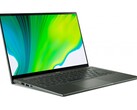Acer Spin 3 SP314: Stylish convertible convinces in review

After the even cheaper and smaller Spin 1, the Spin 3 represents the entry into the convertible series of the Acer manufacturer. The device is available with processors from Intel and AMD in the current SP314 series. Our test unit with the mode number SP314-54N-56S5 is equipped with an Intel Core i5-1035G4 with Iris Plus Graphics G4 and 8 GB of RAM.
Is this configuration enough to make the 799-Euro (~$953) (MSRP) convertible an inexpensive but still good all-rounder? And how does the device perform compared to the convertible competition from other manufacturers like the slightly more expensive Asus VivoBook Flip 14 TM420IA with an AMD R7 4700U and Vega 7 graphics?
Possible contenders in comparison
Rating | Date | Model | Weight | Height | Size | Resolution | Price |
|---|---|---|---|---|---|---|---|
| 84.2 % v7 (old) | 03 / 2021 | Acer Spin 3 SP314-54N-56S5 i5-1035G4, Iris Plus Graphics G4 (Ice Lake 48 EU) | 1.5 kg | 16 mm | 14.00" | 1920x1080 | |
| 88.1 % v7 (old) | 01 / 2021 | Lenovo ThinkBook 14s Yoga ITL 20WE0023GE i7-1165G7, Iris Xe G7 96EUs | 1.5 kg | 16.9 mm | 14.00" | 1920x1080 | |
| 87.2 % v7 (old) | 12 / 2020 | Dell Latitude 5310-23VP6 i5-10310U, UHD Graphics 620 | 1.3 kg | 19.7 mm | 13.30" | 1920x1080 | |
| 80.7 % v7 (old) | 08 / 2020 | Asus VivoBook Flip 14 TM420IA R7 4700U, Vega 7 | 1.6 kg | 18.2 mm | 14.00" | 1920x1080 | |
| 84.3 % v7 (old) | 03 / 2020 | Lenovo Yoga C740-14IML i5-10210U, UHD Graphics 620 | 1.4 kg | 16.9 mm | 14.00" | 1920x1080 | |
| 89.4 % v7 (old) | 12 / 2020 | HP Spectre x360 14t-ea000 i7-1165G7, Iris Xe G7 96EUs | 1.3 kg | 17.2 mm | 13.50" | 1920x1280 |
Case
Acer can't be criticized in terms of quality and craftsmanship. Like the recently reviewed Acer Aspire 5 A517, the device comes in a stylish case made of silver-colored aluminum with a lightly brushed surface that effectively eliminates fingerprints. The design is kept very simple and looks high-quality. There's also nothing to complain about in terms of build quality in our test device.
The hinges that hold the display provide the device with high stability. The same is true for the case, so that the device can also be carried around grabbed by a corner when it's opened. However, the hinges are so stiff that the device can only be opened with one hand with a bit of skill.
As is usual for a convertible, the top part can be folded by 360 degrees towards the bottom of the device. It can be used in four different positions: In laptop and tablet mode as well as in tent and display mode. Windows immediately detects the orientation change and switches to the corresponding laptop or tablet mode (the system might show a confirmation prompt).
If we compare the Acer Spin 3 SP314 with the Asus VivoBook Flip 14 TM420IA 14-inch competitor, the devices are almost identical in terms of dimensions. Some other comparison candidates are much more compact, but they also have displays that are 0.7 to 0.5 inches smaller. Overall, there's not much that Acer has done wrong with the device's size. The unit is sufficiently thin for transportation at 16 mm, and it doesn't show excessive width or depth thanks to the thin display edges, especially at the left and right sides.
The device weighs 1.4 kg. This places it pretty much in the midfield of the comparison models; it's even 0.1 kg lighter than the similarly priced Asus VivoBook Flip 14 TM420IA. This is a perfectly acceptable weight for a laptop, even though there are definitely even lighter 14-inch devices. Since the top and bottom parts are attached together, the device weighs the same in tablet mode too. This quickly makes it quite heavy in tablet mode, and it definitely can't keep up with actual tablets. Convertibles are and remain a compromise. It's best to place the device on a table or on the lap when in tablet mode.
Connectivity
The two USB-A ports are distributed on both sides of the device; a Thunderbolt 3/USB-C port with Power Delivery is only available on the left. The power adapter, HDMI connectors, and memory cards also have their corresponding slots there. On the right side, there's the power button, which is easy to reach even in tablet mode, and a combined audio jack for headsets and the like.
The Acer Active Stylus is also located on the right side. The stylus sits inside the case, but it can't be removed with one hand when the device is placed on a table. It's held quite tightly in its place, which makes it harder to lose. Otherwise, there's little to criticize about the accessibility and usability of the ports.
SD card reader
A positive aspect is that the device has a slot for microSD memory cards integrated into the case. That's the only pro, however, because the reader disappoints in the test with below-average performance, ranking worst among the comparison models. Users who want to use the SD card reader frequently, e.g. to transfer photos from a camera, should either be prepared for longer transfer times or use a different device.
| SD Card Reader | |
| average JPG Copy Test (av. of 3 runs) | |
| HP Spectre x360 14t-ea000 (Toshiba Exceria Pro M501 microSDXC 32GB) | |
| Dell Latitude 5310-23VP6 (Toshiba Exceria Pro M501 microSDXC 64GB) | |
| Lenovo ThinkBook 14s Yoga ITL 20WE0023GE (Toshiba Exceria Pro M501 microSDXC 64GB) | |
| Average of class Convertible (22.4 - 209, n=24, last 2 years) | |
| Asus VivoBook Flip 14 TM420IA (Toshiba Exceria Pro M501 microSDXC 64GB) | |
| Acer Spin 3 SP314-54N-56S5 (Toshiba Exceria Pro M501 microSDXC 64GB) | |
| maximum AS SSD Seq Read Test (1GB) | |
| HP Spectre x360 14t-ea000 (Toshiba Exceria Pro M501 microSDXC 32GB) | |
| Dell Latitude 5310-23VP6 (Toshiba Exceria Pro M501 microSDXC 64GB) | |
| Average of class Convertible (25.2 - 253, n=23, last 2 years) | |
| Lenovo ThinkBook 14s Yoga ITL 20WE0023GE (Toshiba Exceria Pro M501 microSDXC 64GB) | |
| Asus VivoBook Flip 14 TM420IA (Toshiba Exceria Pro M501 microSDXC 64GB) | |
| Acer Spin 3 SP314-54N-56S5 (Toshiba Exceria Pro M501 microSDXC 64GB) | |
Communication
Unfortunately, the Spin 3 doesn't have a wireless module for mobile networks. However, thanks to Intel's AX201, at least Wi-Fi 6 (802.11ax/ac/a/b/g/n) is available. However, the module is unfortunately unable to reach its full potential in our review sample and lags slightly behind the average instead. Nevertheless, the Acer Spin 3 SP314 manages to beat the Asus VivoBook Flip 14 TM420IA by a respectable margin; the latter is slower and has poorer Wi-Fi connectivity. Bluetooth 5.0 is also available for wireless connections.
Webcam
Acer has installed a 720p camera that makes a solid impression in the test in daylight considering its capabilities. It's absolutely sufficient for video calls.
Security
The security features of the Acer Spin 3 A314 are limited to a Kensington slot on the right side and a fingerprint scanner that is integrated into the touchpad.
Accessories
Besides the mandatory power adapter, Acer includes the aforementioned Acer Active Stylus that supports Wacom's AES 1.0 with the Spin 3. The small stylus fits quite well in the hand despite its thin build and features a button that enables right-clicking. It's charged in the case, and within 15 seconds, it's ready to do its job again for 90 minutes. Acer doesn't include any other accessories in the box, but it does offer optional accessories in its online store.
Maintenance
Warranty
Acer grants buyers a 24-month warranty out of the box. Warranty extensions can be purchased as an option.
Input devices
Keyboard
Due to the relatively narrow edges on the left and right, Acer packs a sufficiently large keyboard into the compact case. However, the keys could certainly be a bit bigger to allow for a more relaxed hand position, but this isn't feasible in a 14-inch device. Besides the classic layout and the usual functions of the F keys, such as volume and display brightness control, there are no special keys.
Nevertheless, the typing experience is good, and inputs are implemented quite smoothly. The keyboard is pleasantly quiet and hardly rattles. The backlighting ensures that the individual keys are easy to recognize even in less ideal lighting conditions.
Touchpad
The touchpad is sufficiently large at about 10 x 6.5 cm and is slightly offset to the left below the space bar. The surface provides fingers with a pleasant sensation when they glide on it. Using the area for swiping gestures works flawlessly so far, including scrolling with two fingers.
Unfortunately, there's no palpable border between the left and right click areas. If you click relatively in the center, you can easily hit the wrong button side. We noticed another negative aspect during the use of our test device: The left button doesn't respond to input all the way into the lower, outward-facing corner. Users who have the habit of pressing the touchpad's "mouse buttons" far in the corners will regularly be let down. This problem doesn't happen with the right button. Unfortunately, we can't know for sure if this is a defect in our test device or a problem in the series. However, anyone who has the same problem with the device is welcome to leave a note below in the comments.
Display
As befits a convertible, the Acer Spin 3 SP314 is also equipped with a touchpad display. It's a 14-inch panel with a Full HD resolution, i.e. 1920x1080 pixels. We would definitely recommend using the included stylus for touch input. When you use your fingers, the display quickly gets ugly smudges on it, which is a negative feature of almost any touchscreen, though.
Even though Acer has installed a glossy and not a matte screen in the device, reflections are kept within limits. Indoors, they are only bothersome to a limited extent; as long as there is no window or other direct light source facing the screen, reflections are in control. However, they are more of a problem outdoors.
The display's brightness distribution is quite even, but it could be a bit brighter at an average of 270 cd/m². In the dark, minor backlight bleeding occurs at the upper edge of the screen; this can be seen very clearly in the photo taken with an extended exposure time.
| |||||||||||||||||||||||||
Brightness Distribution: 92 %
Center on Battery: 271 cd/m²
Contrast: 1426:1 (Black: 0.19 cd/m²)
ΔE ColorChecker Calman: 4.24 | ∀{0.5-29.43 Ø4.79}
ΔE Greyscale Calman: 2.51 | ∀{0.09-98 Ø5}
58% sRGB (Argyll 1.6.3 3D)
37% AdobeRGB 1998 (Argyll 1.6.3 3D)
40.55% AdobeRGB 1998 (Argyll 3D)
58.2% sRGB (Argyll 3D)
39.25% Display P3 (Argyll 3D)
Gamma: 2.25
CCT: 6812 K
| Acer Spin 3 SP314-54N-56S5 BOE081D, IPS, 1920x1080, 14" | Lenovo ThinkBook 14s Yoga ITL 20WE0023GE Innolux N140HCG-EQ1, IPS, 1920x1080, 14" | Dell Latitude 5310-23VP6 Chi Mei CMN1382, IPS, 1920x1080, 13.3" | Asus VivoBook Flip 14 TM420IA BOE NV140FHM-N49, IPS, 1920x1080, 14" | Lenovo Yoga C740-14IML CMN N140HCE-ET2, IPS, 1920x1080, 14" | HP Spectre x360 14t-ea000 LG Philips LGD0663, IPS, 1920x1280, 13.5" | |
|---|---|---|---|---|---|---|
| Display | 51% | 71% | 3% | 72% | 68% | |
| Display P3 Coverage (%) | 39.25 | 59.4 51% | 67.5 72% | 40.47 3% | 67.9 73% | 65.8 68% |
| sRGB Coverage (%) | 58.2 | 88.7 52% | 99 70% | 60 3% | 98.3 69% | 98.2 69% |
| AdobeRGB 1998 Coverage (%) | 40.55 | 61.3 51% | 69.2 71% | 41.81 3% | 70.1 73% | 67.9 67% |
| Response Times | -96% | -37% | -58% | -77% | -131% | |
| Response Time Grey 50% / Grey 80% * (ms) | 29 ? | 50 ? -72% | 36 ? -24% | 36.4 ? -26% | 35.6 ? -23% | 62 ? -114% |
| Response Time Black / White * (ms) | 16 ? | 35 ? -119% | 24 ? -50% | 30.4 ? -90% | 36.8 ? -130% | 39.6 ? -148% |
| PWM Frequency (Hz) | 1000 ? | 2500 ? | 27030 ? | |||
| Screen | 28% | 19% | -44% | -7% | 36% | |
| Brightness middle (cd/m²) | 271 | 304 12% | 383 41% | 272.5 1% | 329.9 22% | 443.5 64% |
| Brightness (cd/m²) | 272 | 289 6% | 364 34% | 260 -4% | 315 16% | 394 45% |
| Brightness Distribution (%) | 92 | 90 -2% | 84 -9% | 88 -4% | 90 -2% | 78 -15% |
| Black Level * (cd/m²) | 0.19 | 0.1 47% | 0.34 -79% | 0.42 -121% | 0.29 -53% | 0.17 11% |
| Contrast (:1) | 1426 | 3040 113% | 1126 -21% | 649 -54% | 1138 -20% | 2609 83% |
| Colorchecker dE 2000 * | 4.24 | 2.97 30% | 2.24 47% | 4.65 -10% | 3.68 13% | 2.7 36% |
| Colorchecker dE 2000 max. * | 6.38 | 5.69 11% | 3.32 48% | 17.78 -179% | 8.64 -35% | 4.36 32% |
| Greyscale dE 2000 * | 2.51 | 3.58 -43% | 2.42 4% | 4.4 -75% | 6.4 -155% | 3.4 -35% |
| Gamma | 2.25 98% | 2.17 101% | 2.65 83% | 2.2 100% | 2.17 101% | 2.09 105% |
| CCT | 6812 95% | 6346 102% | 6776 96% | 6984 93% | 6195 105% | 6144 106% |
| Color Space (Percent of AdobeRGB 1998) (%) | 37 | 56 51% | 56 51% | 38.4 4% | 63.6 72% | 62.1 68% |
| Color Space (Percent of sRGB) (%) | 58 | 89 53% | 99 71% | 59.8 3% | 98.4 70% | 98.5 70% |
| Colorchecker dE 2000 calibrated * | 0.59 | 0.72 | 4.34 | 1.03 | 2.61 | |
| Total Average (Program / Settings) | -6% /
16% | 18% /
22% | -33% /
-36% | -4% /
-1% | -9% /
20% |
* ... smaller is better
The built-in IPS panel covers just 58% of the sRGB color space. In this respect, the device clearly lags behind most comparison candidates - except for the VivoBook Flip 14 that is positioned in the same price range. However, this is still sufficient for normal users. On the other hand, the device scores much better in terms of contrast ratio, black level, and response times.
Thanks to its solid brightness, the Spin 3 SP314 can also be used outdoors in the absence of direct sunlight and when placed at a favorable angle despite its glossy display. However, it can't compete with devices that have a matte display, which is why it's definitely more suitable for the living room or home office and less for the garden.
Display Response Times
| ↔ Response Time Black to White | ||
|---|---|---|
| 16 ms ... rise ↗ and fall ↘ combined | ↗ 4 ms rise | |
| ↘ 12 ms fall | ||
| The screen shows good response rates in our tests, but may be too slow for competitive gamers. In comparison, all tested devices range from 0.1 (minimum) to 240 (maximum) ms. » 36 % of all devices are better. This means that the measured response time is better than the average of all tested devices (20.3 ms). | ||
| ↔ Response Time 50% Grey to 80% Grey | ||
| 29 ms ... rise ↗ and fall ↘ combined | ↗ 5 ms rise | |
| ↘ 24 ms fall | ||
| The screen shows relatively slow response rates in our tests and may be too slow for gamers. In comparison, all tested devices range from 0.165 (minimum) to 636 (maximum) ms. » 37 % of all devices are better. This means that the measured response time is similar to the average of all tested devices (31.7 ms). | ||
Screen Flickering / PWM (Pulse-Width Modulation)
| Screen flickering / PWM detected | 1000 Hz | ≤ 90 % brightness setting | |
The display backlight flickers at 1000 Hz (worst case, e.g., utilizing PWM) Flickering detected at a brightness setting of 90 % and below. There should be no flickering or PWM above this brightness setting. The frequency of 1000 Hz is quite high, so most users sensitive to PWM should not notice any flickering. In comparison: 53 % of all tested devices do not use PWM to dim the display. If PWM was detected, an average of 8152 (minimum: 5 - maximum: 343500) Hz was measured. | |||
As is familiar with IPS panels and even properly expected from a convertible, the displayed image can still be viewed well even at very sharp viewing angles. As a result, the display can be positioned at any angle that suits the respective use and situation.
Performance
Inside the Acer Spin 3 with the model number SP314-54N-56S5, the manufacturer has installed the 10th generation (Ice Lake) Intel Core i5-1035G4 quad-core CPU. Acer does without a separate graphics solution and relies on the Iris Plus Graphics G4 graphics unit instead. In addition, there's a modest 8 GB of LPDDR4 RAM in dual-channel mode.
Alternatively, Acer also offers the Spin 3 with the same CPU and graphics configuration but with 16 GB of RAM. There are also other configurations, e.g. with the Intel i5-1035G1 and UHD Graphics or the AMD Ryzen 3 3250U. Models with a Tiger Lake CPU are also available now.
Processor
The Intel Core i5-1035G4 runs at a base clock speed of 1.1 GHz. It can boost its clock speed up to 3.7 GHz on one core, 3.6 GHz on two cores, and 3.3 GHz on all four cores as needed.
During the stress test, the CPU's speed remains mostly constant after a slight drop at the beginning. The device can partly stand out quite noticeably from the average of the devices equipped with the Intel Core i5-1035G4 in the executed benchmarks. This shows that Acer knows how to get the best possible out of the CPU. However, the Acer Spin 3 SP314's performance in this configuration is nowhere near that of the Asus VivoBook Flip 14 TM420IA equipped with the AMD Ryzen 7 4700U. As expected, the comparison models equipped with the Intel Core i7-1165G7 also leave it slightly behind.
Cinebench R15: CPU Single 64Bit | CPU Multi 64Bit
Blender: v2.79 BMW27 CPU
7-Zip 18.03: 7z b 4 -mmt1 | 7z b 4
Geekbench 5.5: Single-Core | Multi-Core
HWBOT x265 Benchmark v2.2: 4k Preset
LibreOffice : 20 Documents To PDF
R Benchmark 2.5: Overall mean
| Cinebench R20 / CPU (Single Core) | |
| Average of class Convertible (348 - 827, n=58, last 2 years) | |
| Lenovo ThinkBook 14s Yoga ITL 20WE0023GE | |
| HP Spectre x360 14t-ea000 | |
| Asus VivoBook Flip 14 TM420IA | |
| Acer Spin 3 SP314-54N-56S5 | |
| Lenovo Yoga C740-14IML | |
| Dell Latitude 5310-23VP6 | |
| Average Intel Core i5-1035G4 (357 - 441, n=6) | |
| Cinebench R20 / CPU (Multi Core) | |
| Average of class Convertible (1124 - 11357, n=58, last 2 years) | |
| Asus VivoBook Flip 14 TM420IA | |
| HP Spectre x360 14t-ea000 | |
| Lenovo ThinkBook 14s Yoga ITL 20WE0023GE | |
| Acer Spin 3 SP314-54N-56S5 | |
| Lenovo Yoga C740-14IML | |
| Average Intel Core i5-1035G4 (892 - 1648, n=6) | |
| Dell Latitude 5310-23VP6 | |
| Cinebench R15 / CPU Single 64Bit | |
| Average of class Convertible (149.8 - 317, n=58, last 2 years) | |
| HP Spectre x360 14t-ea000 | |
| Lenovo ThinkBook 14s Yoga ITL 20WE0023GE | |
| Asus VivoBook Flip 14 TM420IA | |
| Acer Spin 3 SP314-54N-56S5 | |
| Lenovo Yoga C740-14IML | |
| Dell Latitude 5310-23VP6 | |
| Average Intel Core i5-1035G4 (146.4 - 172, n=5) | |
| Cinebench R15 / CPU Multi 64Bit | |
| Average of class Convertible (478 - 4830, n=61, last 2 years) | |
| Asus VivoBook Flip 14 TM420IA | |
| HP Spectre x360 14t-ea000 | |
| Lenovo ThinkBook 14s Yoga ITL 20WE0023GE | |
| Lenovo Yoga C740-14IML | |
| Acer Spin 3 SP314-54N-56S5 | |
| Average Intel Core i5-1035G4 (490 - 676, n=6) | |
| Dell Latitude 5310-23VP6 | |
| Blender / v2.79 BMW27 CPU | |
| Average Intel Core i5-1035G4 (703 - 1075, n=6) | |
| Dell Latitude 5310-23VP6 | |
| Acer Spin 3 SP314-54N-56S5 | |
| Lenovo ThinkBook 14s Yoga ITL 20WE0023GE | |
| HP Spectre x360 14t-ea000 | |
| Asus VivoBook Flip 14 TM420IA | |
| Average of class Convertible (107 - 1051, n=57, last 2 years) | |
| 7-Zip 18.03 / 7z b 4 -mmt1 | |
| Lenovo ThinkBook 14s Yoga ITL 20WE0023GE | |
| Average of class Convertible (3672 - 6540, n=58, last 2 years) | |
| HP Spectre x360 14t-ea000 | |
| Asus VivoBook Flip 14 TM420IA | |
| Dell Latitude 5310-23VP6 | |
| Acer Spin 3 SP314-54N-56S5 | |
| Average Intel Core i5-1035G4 (1307 - 4190, n=6) | |
| 7-Zip 18.03 / 7z b 4 | |
| Average of class Convertible (12977 - 121368, n=58, last 2 years) | |
| Asus VivoBook Flip 14 TM420IA | |
| HP Spectre x360 14t-ea000 | |
| Lenovo ThinkBook 14s Yoga ITL 20WE0023GE | |
| Acer Spin 3 SP314-54N-56S5 | |
| Dell Latitude 5310-23VP6 | |
| Average Intel Core i5-1035G4 (11030 - 19548, n=6) | |
| Geekbench 5.5 / Single-Core | |
| Average of class Convertible (806 - 2275, n=57, last 2 years) | |
| Lenovo ThinkBook 14s Yoga ITL 20WE0023GE | |
| HP Spectre x360 14t-ea000 | |
| Acer Spin 3 SP314-54N-56S5 | |
| Average Intel Core i5-1035G4 (1081 - 1277, n=5) | |
| Asus VivoBook Flip 14 TM420IA | |
| Dell Latitude 5310-23VP6 | |
| Geekbench 5.5 / Multi-Core | |
| Average of class Convertible (2188 - 22023, n=57, last 2 years) | |
| Asus VivoBook Flip 14 TM420IA | |
| HP Spectre x360 14t-ea000 | |
| Lenovo ThinkBook 14s Yoga ITL 20WE0023GE | |
| Acer Spin 3 SP314-54N-56S5 | |
| Average Intel Core i5-1035G4 (3261 - 4315, n=5) | |
| Dell Latitude 5310-23VP6 | |
| HWBOT x265 Benchmark v2.2 / 4k Preset | |
| Average of class Convertible (3.43 - 36.2, n=58, last 2 years) | |
| Asus VivoBook Flip 14 TM420IA | |
| HP Spectre x360 14t-ea000 | |
| Lenovo ThinkBook 14s Yoga ITL 20WE0023GE | |
| Acer Spin 3 SP314-54N-56S5 | |
| Average Intel Core i5-1035G4 (3.37 - 5.61, n=6) | |
| Dell Latitude 5310-23VP6 | |
| LibreOffice / 20 Documents To PDF | |
| Average Intel Core i5-1035G4 (58.4 - 78.3, n=5) | |
| Dell Latitude 5310-23VP6 | |
| Acer Spin 3 SP314-54N-56S5 | |
| Asus VivoBook Flip 14 TM420IA | |
| Average of class Convertible (42.5 - 84.3, n=57, last 2 years) | |
| HP Spectre x360 14t-ea000 | |
| Lenovo ThinkBook 14s Yoga ITL 20WE0023GE | |
| R Benchmark 2.5 / Overall mean | |
| Average Intel Core i5-1035G4 (0.701 - 0.825, n=5) | |
| Dell Latitude 5310-23VP6 | |
| Acer Spin 3 SP314-54N-56S5 | |
| Asus VivoBook Flip 14 TM420IA | |
| HP Spectre x360 14t-ea000 | |
| Lenovo ThinkBook 14s Yoga ITL 20WE0023GE | |
| Average of class Convertible (0.3985 - 0.84, n=57, last 2 years) | |
* ... smaller is better
System performance
System performance also shows a similar picture. Once again, our review sample usually surpasses the average performance of laptops equipped with the same CPU and graphics solution. It also considerably surpasses the convertible average. However, the comparison with the Asus VivoBook Flip 14 TM420IA that belongs to the same price range once again shows that the Ice Lake generation i5 can't keep up with the current Ryzen 7 4700U and its Vega 7 graphics, but it's run into the ground instead.
| PCMark 8 Home Score Accelerated v2 | 4072 points | |
| PCMark 8 Work Score Accelerated v2 | 2729 points | |
| PCMark 10 Score | 3885 points | |
Help | ||
DPC latencies
| DPC Latencies / LatencyMon - interrupt to process latency (max), Web, Youtube, Prime95 | |
| HP Spectre x360 14t-ea000 | |
| Acer Spin 3 SP314-54N-56S5 | |
| Dell Latitude 5310-23VP6 | |
| Lenovo ThinkBook 14s Yoga ITL 20WE0023GE | |
| Asus VivoBook Flip 14 TM420IA | |
* ... smaller is better
Storage
The built-in mass storage device in the form of the SK hynix BC511 HFM256GDJTNI-82A0 NVMe SSD has a modest capacity of 256 GB. Acer can also equip the Spin 3 SP314 with up to 1 TB if desired. The storage drive delivers solid rates in the test, but it can't keep up with the higher-priced competition. Compared to all the devices with the same storage, the unit performs slightly above average.
| Acer Spin 3 SP314-54N-56S5 SK hynix BC511 HFM256GDJTNI-82A0 | Lenovo ThinkBook 14s Yoga ITL 20WE0023GE SK Hynix BC711 HFM512GD3HX015N | Dell Latitude 5310-23VP6 SK hynix BC511 HFM512GDHTNI-87A0B | Asus VivoBook Flip 14 TM420IA Samsung PM991 MZVLQ512HALU | Lenovo Yoga C740-14IML Samsung SSD PM981a MZVLB256HBHQ | HP Spectre x360 14t-ea000 Samsung SSD PM981a MZVLB512HBJQ | Average SK hynix BC511 HFM256GDJTNI-82A0 | |
|---|---|---|---|---|---|---|---|
| CrystalDiskMark 5.2 / 6 | 105% | -1% | 12% | 57% | 70% | -6% | |
| Write 4K (MB/s) | 165.2 | 235.9 43% | 119.1 -28% | 121.2 -27% | 125.6 -24% | 82.2 -50% | 119.5 ? -28% |
| Read 4K (MB/s) | 55 | 70.3 28% | 43.41 -21% | 49.91 -9% | 43.46 -21% | 45.7 -17% | 43.9 ? -20% |
| Write Seq (MB/s) | 1015 | 2577 154% | 1077 6% | 1090 7% | 2011 98% | 2000 97% | 898 ? -12% |
| Read Seq (MB/s) | 1125 | 2556 127% | 1071 -5% | 1533 36% | 2046 82% | 2206 96% | 1104 ? -2% |
| Write 4K Q32T1 (MB/s) | 423.6 | 635 50% | 348.5 -18% | 393.3 -7% | 375.8 -11% | 451.2 7% | 380 ? -10% |
| Read 4K Q32T1 (MB/s) | 483.8 | 701 45% | 349.4 -28% | 406 -16% | 338.1 -30% | 351 -27% | 432 ? -11% |
| Write Seq Q32T1 (MB/s) | 648 | 2581 298% | 1055 63% | 1225 89% | 2346 262% | 2982 360% | 823 ? 27% |
| Read Seq Q32T1 (MB/s) | 1802 | 3557 97% | 2292 27% | 2277 26% | 3562 98% | 3529 96% | 1998 ? 11% |
| AS SSD | 141% | 29% | 24% | 48% | 115% | -1% | |
| Seq Read (MB/s) | 1871 | 2893 55% | 1796 -4% | 1397 -25% | 1719 -8% | 2188 17% | 1743 ? -7% |
| Seq Write (MB/s) | 703 | 2498 255% | 741 5% | 783 11% | 1211 72% | 1320 88% | 758 ? 8% |
| 4K Read (MB/s) | 45.97 | 60.8 32% | 48.33 5% | 48.08 5% | 53.1 16% | 53.5 16% | 43.5 ? -5% |
| 4K Write (MB/s) | 119.3 | 203.1 70% | 123.3 3% | 134.6 13% | 131.4 10% | 123.7 4% | 114.5 ? -4% |
| 4K-64 Read (MB/s) | 614 | 1758 186% | 731 19% | 835 36% | 508 -17% | 1010 64% | 604 ? -2% |
| 4K-64 Write (MB/s) | 367.1 | 1608 338% | 754 105% | 734 100% | 883 141% | 1808 393% | 475 ? 29% |
| Access Time Read * (ms) | 0.084 | 0.039 54% | 0.04 52% | 0.081 4% | 0.05 40% | 0.055 35% | 0.07886 ? 6% |
| Access Time Write * (ms) | 0.038 | 0.029 24% | 0.031 18% | 0.084 -121% | 0.085 -124% | 0.076 -100% | 0.04713 ? -24% |
| Score Read (Points) | 847 | 2108 149% | 959 13% | 1022 21% | 733 -13% | 1282 51% | 822 ? -3% |
| Score Write (Points) | 557 | 2061 270% | 952 71% | 947 70% | 1135 104% | 2063 270% | 665 ? 19% |
| Score Total (Points) | 1792 | 5234 192% | 2362 32% | 2474 38% | 2235 25% | 3970 122% | 1870 ? 4% |
| Copy ISO MB/s (MB/s) | 1168 | 1985 70% | 1212 4% | 1636 40% | 1644 41% | 886 ? -24% | |
| Copy Program MB/s (MB/s) | 459.8 | 530 15% | 374.3 -19% | 698 52% | 920 100% | 253 ? -45% | |
| Copy Game MB/s (MB/s) | 283 | 1031 264% | 829 193% | 1246 340% | 1725 510% | 365 ? 29% | |
| Total Average (Program / Settings) | 123% /
128% | 14% /
17% | 18% /
20% | 53% /
51% | 93% /
99% | -4% /
-3% |
* ... smaller is better
Continuous load read: DiskSpd Read Loop, Queue Depth 8
Graphics card
As already mentioned, Acer doesn't provide the Spin 3 SP314 with a dedicated graphics solution in this configuration. Therefore, the 11th generation Iris Plus Graphics G4 GPU, in which 48 of the 64 shader clusters run at 300 to 1,050 MHz, has to handle the task.
It's certainly sufficient for the everyday tasks of a convertible such as using office applications, browsing, and streaming. However, the device is definitely the wrong choice for complex tasks like more demanding games. This is also evident in the benchmarks with 3DMark, where the device can at least position itself above the average of all the devices with the Intel Iris Plus Graphics G4 GPU. However, as expected, it lags far behind the newer Intel Iris Xe Graphics G7.
| 3DMark 11 Performance | 3544 points | |
| 3DMark Cloud Gate Standard Score | 11999 points | |
| 3DMark Fire Strike Score | 2054 points | |
Help | ||
Gaming performance
Without a doubt, an inexpensive convertible like this one is not a gaming machine. The Acer Spin 3 SP314 clearly shows this in the test as well.
The already somewhat older The Witcher 3 runs passably at the lowest level, at low resolution, and with few details. However, as soon as the graphics settings are set to the full display resolution of 1920x1080 pixels or a higher level of detail is chosen, the rather fast-paced experience in our test sequence quickly turns into an unplayable slow-motion nightmare. Thankfully, the graphics unit in our test device always achieves at least the average of all the test candidates with the Intel Iris Plus Graphics G4 (Ice Lake 48 EU).
In short: It might be enough for a few games with low hardware requirements. More is not possible, but it shouldn't be demanded or expected either considering the device's configuration and focus.
| low | med. | high | ultra | |
|---|---|---|---|---|
| The Witcher 3 (2015) | 35.65 | 23.42 | 12.91 | 7.375 |
| Dota 2 Reborn (2015) | 81.2 | 43.6 | 23.2 | 20.9 |
Emissions
Noise emissions
In the configuration at hand, the Acer Spin 3 SP314 remains pleasantly quiet even under load. At just under 33 dB(A), it's audible but not truly bothersome. The device is no longer audible in idle mode and under low load. Other noise apart from the typical fan noise didn't occur in our test device.
Noise level
| Idle |
| 24.9 / 24.9 / 26 dB(A) |
| Load |
| 32.6 / 32.8 dB(A) |
 | ||
30 dB silent 40 dB(A) audible 50 dB(A) loud |
||
min: | ||
Temperature
A convertible like this one doesn't always sit on a table or on the lap. Instead, devices like these are sometimes held in the hand for a short time, especially in tablet mode. Therefore, excessive heat development would not be very beneficial. Fortunately, this doesn't occur in the Spin 3. Even under load, it heats up to a maximum of 35 °C (~95 °F) and remains below body temperature as a result. The device can always be held without issues. When opened, the upper left area up to the device's midsection is the warmest, which is where the fan outlet is centrally located. The palm rest area is pleasantly cool even under load.
In our stress test, where Prime95 and FurMark push the device's CPU and GPU for at least an hour, Acer's convertible didn't show any major weaknesses. Even though the temperatures of the CPU cores rose up to 75 °C (~167 °F) in the course of time, the clock rate remained relatively constant. Only the operating speed of the graphics core dropped slightly over time. No throttling could be detected in the test, so that no restrictions are to be expected within the scope of the components' capabilities even when the hardware is subjected to prolonged load by more demanding tasks.
(+) The maximum temperature on the upper side is 33.9 °C / 93 F, compared to the average of 35.4 °C / 96 F, ranging from 19.6 to 60 °C for the class Convertible.
(+) The bottom heats up to a maximum of 35.1 °C / 95 F, compared to the average of 36.8 °C / 98 F
(+) In idle usage, the average temperature for the upper side is 24.3 °C / 76 F, compared to the device average of 30.3 °C / 87 F.
(+) The palmrests and touchpad are cooler than skin temperature with a maximum of 27 °C / 80.6 F and are therefore cool to the touch.
(±) The average temperature of the palmrest area of similar devices was 27.9 °C / 82.2 F (+0.9 °C / 1.6 F).
Speakers
A convertible is probably used more often for media consumption such as watching videos than a conventional laptop is. Consequently, the speakers play a more important role. Mids and trebles are solid. However, bass is almost completely lacking. The maximum possible volume is also only mediocre.
On the whole, the two stereo speakers are absolutely sufficient for video conferencing. Watching one or the other video or even a movie is also possible to a certain extent. However, external solutions like headphones are recommended for music, especially because of the lack of bass. Compared to the Asus VivoBook Flip 14 TM420IA, which is in the same price range, the Flip 3 scores worse.
Acer Spin 3 SP314-54N-56S5 audio analysis
(±) | speaker loudness is average but good (74.4 dB)
Bass 100 - 315 Hz
(-) | nearly no bass - on average 33.8% lower than median
(±) | linearity of bass is average (11.3% delta to prev. frequency)
Mids 400 - 2000 Hz
(+) | balanced mids - only 3.7% away from median
(±) | linearity of mids is average (8.1% delta to prev. frequency)
Highs 2 - 16 kHz
(±) | higher highs - on average 5.3% higher than median
(+) | highs are linear (5.6% delta to prev. frequency)
Overall 100 - 16.000 Hz
(±) | linearity of overall sound is average (25.3% difference to median)
Compared to same class
» 76% of all tested devices in this class were better, 6% similar, 18% worse
» The best had a delta of 6%, average was 20%, worst was 57%
Compared to all devices tested
» 77% of all tested devices were better, 5% similar, 18% worse
» The best had a delta of 4%, average was 24%, worst was 134%
Asus VivoBook Flip 14 TM420IA audio analysis
(±) | speaker loudness is average but good (79.2 dB)
Bass 100 - 315 Hz
(±) | reduced bass - on average 13.2% lower than median
(±) | linearity of bass is average (9.8% delta to prev. frequency)
Mids 400 - 2000 Hz
(+) | balanced mids - only 1.8% away from median
(+) | mids are linear (4.5% delta to prev. frequency)
Highs 2 - 16 kHz
(+) | balanced highs - only 3% away from median
(+) | highs are linear (2.9% delta to prev. frequency)
Overall 100 - 16.000 Hz
(+) | overall sound is linear (11.5% difference to median)
Compared to same class
» 9% of all tested devices in this class were better, 3% similar, 88% worse
» The best had a delta of 6%, average was 20%, worst was 57%
Compared to all devices tested
» 7% of all tested devices were better, 2% similar, 91% worse
» The best had a delta of 4%, average was 24%, worst was 134%
Energy management
Energy consumption
The Acer Spin 3 SP314 is relatively energy-efficient in idle mode; it keeps up well with the comparison models and is even below the convertible average. However, as soon as the device is under load, it's still on par with the selected comparison models, but it consumes significantly more than the convertible average. The included 65-watt power adapter still provides quite a bit of headroom in any situation, e.g. for powering external devices via USB.
| Off / Standby | |
| Idle | |
| Load |
|
Key:
min: | |
| Acer Spin 3 SP314-54N-56S5 i5-1035G4, Iris Plus Graphics G4 (Ice Lake 48 EU), SK hynix BC511 HFM256GDJTNI-82A0, IPS, 1920x1080, 14" | Lenovo ThinkBook 14s Yoga ITL 20WE0023GE i7-1165G7, Iris Xe G7 96EUs, SK Hynix BC711 HFM512GD3HX015N, IPS, 1920x1080, 14" | Dell Latitude 5310-23VP6 i5-10310U, UHD Graphics 620, SK hynix BC511 HFM512GDHTNI-87A0B, IPS, 1920x1080, 13.3" | Asus VivoBook Flip 14 TM420IA R7 4700U, Vega 7, Samsung PM991 MZVLQ512HALU, IPS, 1920x1080, 14" | Lenovo Yoga C740-14IML i5-10210U, UHD Graphics 620, Samsung SSD PM981a MZVLB256HBHQ, IPS, 1920x1080, 14" | HP Spectre x360 14t-ea000 i7-1165G7, Iris Xe G7 96EUs, Samsung SSD PM981a MZVLB512HBJQ, IPS, 1920x1280, 13.5" | Average Intel Iris Plus Graphics G4 (Ice Lake 48 EU) | Average of class Convertible | |
|---|---|---|---|---|---|---|---|---|
| Power Consumption | -1% | 1% | -2% | -2% | 2% | -2% | -31% | |
| Idle Minimum * (Watt) | 3.4 | 3.6 -6% | 2.9 15% | 4 -18% | 3 12% | 3 12% | 3.26 ? 4% | 4.45 ? -31% |
| Idle Average * (Watt) | 6 | 6.3 -5% | 5.9 2% | 6.4 -7% | 3.9 35% | 5.1 15% | 7.28 ? -21% | 7.35 ? -23% |
| Idle Maximum * (Watt) | 7.9 | 9.1 -15% | 6.7 15% | 7 11% | 7.3 8% | 6.4 19% | 8.66 ? -10% | 9.77 ? -24% |
| Load Average * (Watt) | 39.6 | 34 14% | 42 -6% | 34.6 13% | 42.5 -7% | 39.6 -0% | 34.4 ? 13% | 45 ? -14% |
| Load Maximum * (Watt) | 41 | 39 5% | 50 -22% | 45.1 -10% | 65.5 -60% | 56.2 -37% | 38.9 ? 5% | 67 ? -63% |
| Witcher 3 ultra * (Watt) | 43 | 35 | 39.6 |
* ... smaller is better
Battery life
Acer promises a battery life of up to 12 hours for the Acer Spin 3. In idle mode, the device was even able to surpass this value with its 48 Wh Li-ion battery.
However, as soon as the device is actively used, which is ultimately the purpose, it shut down after about eight hours in our tests. The device achieved this runtime in the video playback and Wi-Fi tests. This puts it pretty much in the average of the convertibles we have tested so far. However, the device can't keep up at all with the Lenovo ThinkBook 14s Yoga ITL 20WE0023GE with its 11th generation Intel Core (i7-1165G7), which is admittedly also 500 Euros (~$595) more expensive.
| Acer Spin 3 SP314-54N-56S5 i5-1035G4, Iris Plus Graphics G4 (Ice Lake 48 EU), 48 Wh | Lenovo ThinkBook 14s Yoga ITL 20WE0023GE i7-1165G7, Iris Xe G7 96EUs, 60 Wh | Dell Latitude 5310-23VP6 i5-10310U, UHD Graphics 620, 60 Wh | Asus VivoBook Flip 14 TM420IA R7 4700U, Vega 7, 42 Wh | Lenovo Yoga C740-14IML i5-10210U, UHD Graphics 620, 51 Wh | HP Spectre x360 14t-ea000 i7-1165G7, Iris Xe G7 96EUs, 66 Wh | Average of class Convertible | |
|---|---|---|---|---|---|---|---|
| Battery runtime | 45% | 48% | 7% | 21% | 89% | 56% | |
| Reader / Idle (h) | 14 | 23.2 66% | 18.6 33% | 36.4 160% | 25.1 ? 79% | ||
| H.264 (h) | 8.3 | 13.9 67% | 15.2 ? 83% | ||||
| WiFi v1.3 (h) | 7.5 | 10.4 39% | 11.1 48% | 8 7% | 9.2 23% | 11.8 57% | 11.2 ? 49% |
| Witcher 3 ultra (h) | 1.7 | ||||||
| Load (h) | 1.6 | 1.7 6% | 1.7 6% | 2.4 50% | 1.802 ? 13% |
Pros
Cons
Verdict
With the Spin 3 SP314, Acer manages to squeeze the best possible performance out from the built-in hardware in many aspects. This is confirmed by the various benchmarks in our test, in which the device mostly delivered above-average results.
As expected, this isn't enough to reach the best rates. However, the device doesn't show any major weaknesses in the test.
The Acer Spin 3 SP314 in the present configuration with the model number SP314-54N-56S5 is a solid convertible that offers an inexpensive entry into this class. If you're looking for a 2-in-1 device for office and Internet use, you'll make a good choice. If you're willing to spend a good 100 Euros (~$119) more in terms of MSRP, you'll get even more performance for your money with the Asus VivoBook Flip 14 TM420IA, but you'll have to live with a few other compromises such as the lack of Thunderbolt 3 and Wi-Fi 6.
Price and availability
At the time of writing, the Acer Spin 3 SP314 is available with the Intel i5-1035G4, Iris Plus Graphics, 8 of GB RAM, and a 512 GB SSD on newegg for $629. You can also find it on Amazon bundled with extra software and an additional year of protection for $748. Lastly, you also have the option of purchasing it directly in Acer's online store.
Acer Spin 3 SP314-54N-56S5
- 03/17/2021 v7 (old)
Marcus Schwarten













